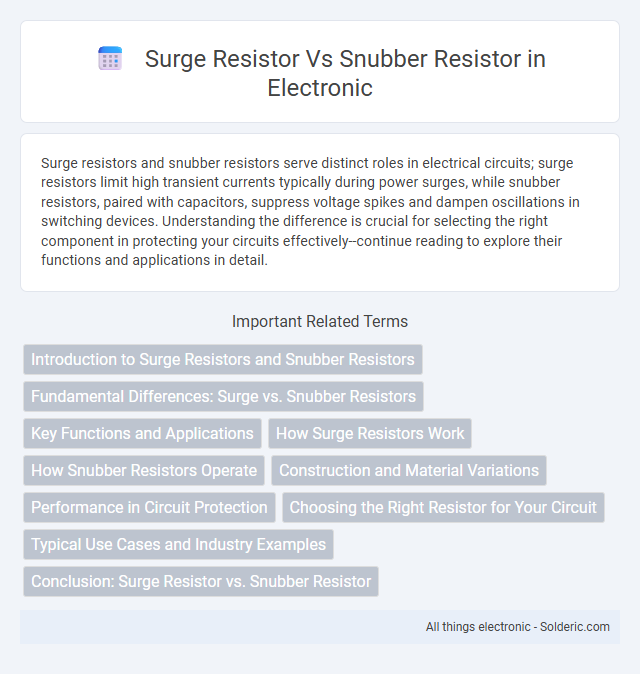Surge resistors and snubber resistors serve distinct roles in electrical circuits; surge resistors limit high transient currents typically during power surges, while snubber resistors, paired with capacitors, suppress voltage spikes and dampen oscillations in switching devices. Understanding the difference is crucial for selecting the right component in protecting your circuits effectively--continue reading to explore their functions and applications in detail.
Comparison Table
| Feature | Surge Resistor | Snubber Resistor |
|---|---|---|
| Purpose | Limits inrush surge current to protect circuits | Works with snubber circuits to suppress voltage spikes |
| Application | Power supplies, motor starters, capacitor charging | Switching devices like transistors, SCRs, and relays |
| Placement | Series with load or power input | Parallel with inductive loads or switching elements |
| Resistance Value | Usually higher to limit high current spikes | Typically lower to quickly dissipate transient energy |
| Energy Dissipation | Absorbs initial surge energy, may generate heat | Dissipates transient spikes, protecting components |
| Typical Components | Wirewound or metal oxide resistors with high power rating | Carbon film or metal oxide resistors with fast response |
Introduction to Surge Resistors and Snubber Resistors
Surge resistors are designed to absorb and dissipate sudden high-energy transients in electrical circuits, protecting components from damage caused by voltage spikes. Snubber resistors, typically paired with capacitors, form snubber circuits that control voltage spikes by limiting the rate of voltage change across sensitive devices such as transistors or thyristors. Understanding the specific roles of surge resistors and snubber resistors helps optimize your circuit protection and improve device reliability.
Fundamental Differences: Surge vs. Snubber Resistors
Surge resistors are designed to absorb high-energy transients and protect circuits from sudden voltage spikes, typically featuring high power ratings and robust construction. In contrast, snubber resistors work within snubber circuits to dampen voltage oscillations and limit transient currents during switching events, usually paired with capacitors or diodes. Understanding these fundamental differences helps you select the appropriate resistor type for protecting sensitive electronic components effectively.
Key Functions and Applications
Surge resistors primarily limit high-voltage spikes by absorbing transient energy in power supply circuits, protecting sensitive components from damage. Snubber resistors work alongside capacitors or diodes to suppress voltage transients and dampen oscillations in switching devices such as transistors and thyristors. Your choice depends on whether you need energy absorption for protection (surge resistor) or oscillation control and transient suppression (snubber resistor) in applications like motor drives or power electronics.
How Surge Resistors Work
Surge resistors absorb and dissipate high-energy voltage spikes to protect sensitive electronic components by limiting the transient current flow. These resistors are designed with high power ratings and special materials to handle sudden surges without damage. Understanding how your surge resistor works ensures reliable circuit protection and prolongs the lifespan of your devices.
How Snubber Resistors Operate
Snubber resistors operate by dissipating energy from voltage spikes generated during the switching of inductive loads, protecting sensitive components from high transient voltages. These resistors work in conjunction with capacitors or diodes to absorb and smooth out the surge energy, reducing electromagnetic interference (EMI) and voltage overshoot. Their precise resistance value is critical to ensure optimal damping without excessive power loss, distinguishing them from surge resistors primarily designed for high-energy absorption.
Construction and Material Variations
Surge resistors are typically constructed with high-energy ceramic cores and thick film coatings to withstand transient high-voltage spikes, while snubber resistors use wirewound or metal oxide film materials designed for precise damping in RC snubber circuits. Materials in surge resistors prioritize high pulse power rating and thermal dissipation, whereas snubber resistors emphasize low inductance and consistent resistance over time. Choosing the right resistor for Your application depends on understanding these construction and material differences to ensure effective voltage surge suppression or circuit damping.
Performance in Circuit Protection
Surge resistors are designed to absorb and dissipate high-energy transient spikes, providing rapid voltage clamping to protect sensitive components from sudden surges. Snubber resistors work in tandem with snubber capacitors to dampen oscillations and limit voltage spikes caused by inductive loads during switching, thereby enhancing circuit stability and longevity. Performance in circuit protection depends on the specific application: surge resistors excel in transient suppression, while snubber resistors focus on reducing voltage noise and preventing damage from switching transients.
Choosing the Right Resistor for Your Circuit
Choosing the right resistor for your circuit requires understanding the distinct roles of surge resistors and snubber resistors; surge resistors limit inrush current to protect components during power-up, while snubber resistors suppress voltage spikes and oscillations caused by inductive loads. Key parameters such as power rating, resistance value, and energy dissipation capacity must match the circuit's operational demands to ensure optimal performance and longevity. Selecting a resistor with proper thermal stability and compatibility with transient voltage characteristics enhances circuit protection and reliability.
Typical Use Cases and Industry Examples
Surge resistors are primarily used in high-voltage power supplies and industrial equipment to limit inrush current and protect sensitive components from voltage spikes, commonly found in power plants and manufacturing automation systems. Snubber resistors are integral in switching power supplies, motor drives, and relay circuits to absorb transient voltage spikes and reduce electromagnetic interference, extensively applied in automotive electronics and renewable energy inverters. Both resistors enhance circuit reliability but serve distinct roles based on transient control requirements in sectors like energy, automotive, and industrial controls.
Conclusion: Surge Resistor vs. Snubber Resistor
Surge resistors and snubber resistors serve distinct but complementary roles in electrical circuits, where surge resistors primarily absorb high-energy transients to protect components from voltage spikes. Snubber resistors work in conjunction with capacitors or inductors to suppress voltage oscillations and control switching noise, enhancing system stability. Selecting between them depends on the specific protection requirements, with surge resistors focusing on transient energy dissipation and snubber resistors optimizing switching performance and preventing voltage overshoot.
surge resistor vs snubber resistor Infographic

 solderic.com
solderic.com